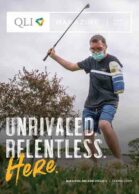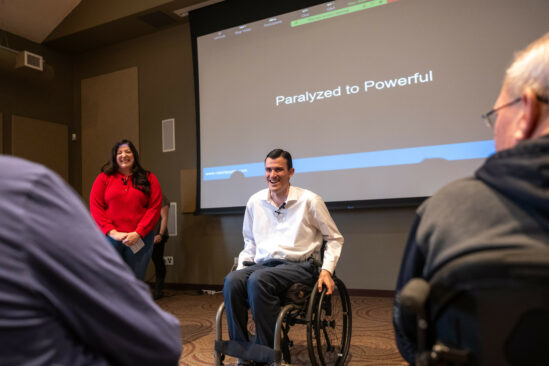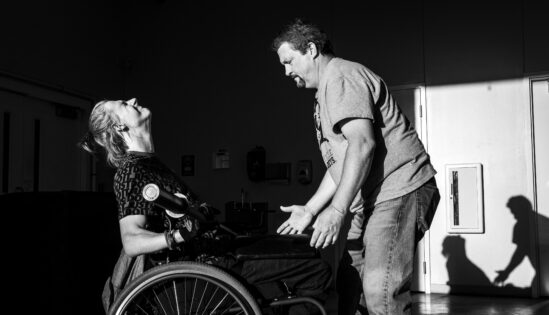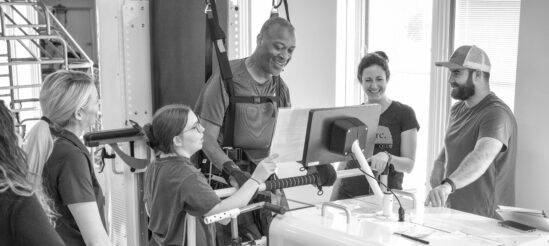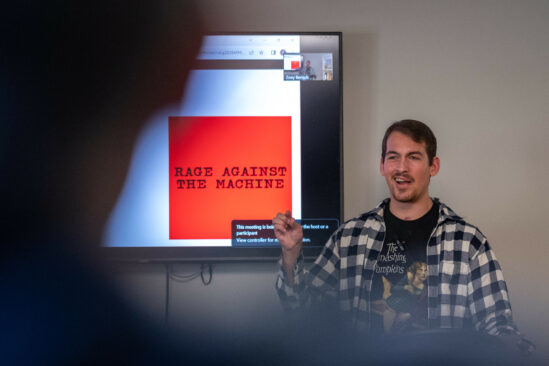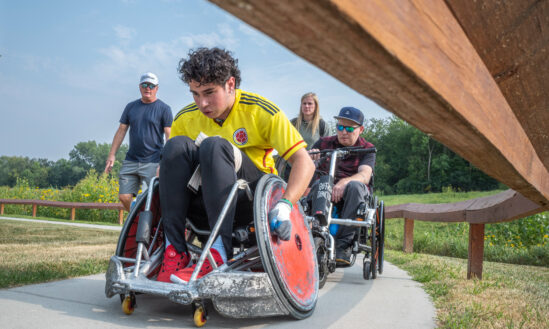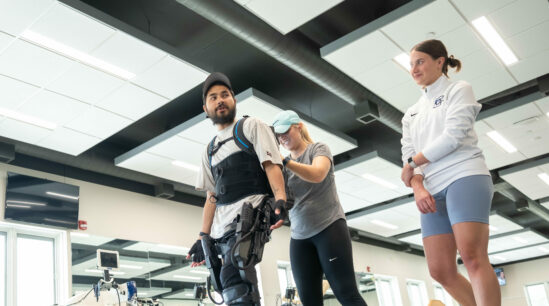How do you prepare for the day that changes your life? How do you react to it, reckon with it? What steps do you take to rebuild and reclaim all that is lost?
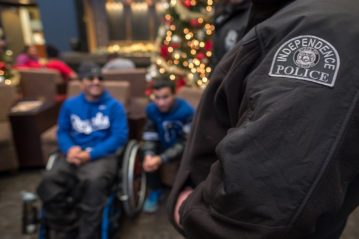 For the Wagstaff family, that day was March 29th, 2017. At 9:58 A.M., Officer Tom Wagstaff and other members of the Independence, Missouri Police Department responded to a home burglary in progress. Upon arrival, the officers surrounded the residence, cornering the suspects inside.
For the Wagstaff family, that day was March 29th, 2017. At 9:58 A.M., Officer Tom Wagstaff and other members of the Independence, Missouri Police Department responded to a home burglary in progress. Upon arrival, the officers surrounded the residence, cornering the suspects inside.
The intruders commandeered a vehicle—an SUV parked inside the home’s garage—and made a desperate, destructive attempt at freedom. Police reports describe the SUV crashing through the garage door toward a blockade of cruisers. The suspects opened fire with small arms to break free, prompting return fire from the officers on the scene.
What was just moments before a peaceful neighborhood had erupted into a hostile, chaotic engagement. Lives hung in the balance. Amidst the panic, the suspects managed a hasty escape from the neighborhood, forcing officers into a brief chase before the SUV and its occupants were eventually apprehended.
The cost, however, proved enormous.
In the firefight, Officer Wagstaff sustained a gunshot wound to the head from a ricocheting bullet. Emergency crews rushed him into surgery. Surgeons repaired much of the critical damage, but chose to leave the round lodged inside Tom’s brain and placed him within a medically induced coma
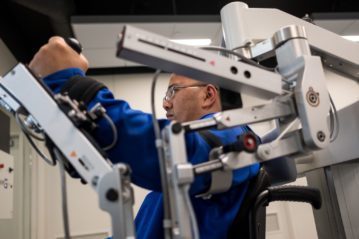 “The news was not really promising,” said Stacy Wagstaff, Tom’s wife. The Wagstaff family was told in no uncertain terms that they should plan for a worst-case scenario. The damage to Tom’s brain had been catastrophic. In the unlikely event that he survived, it was impossible to predict how much of Tom—both physically and cognitively—would remain.
“The news was not really promising,” said Stacy Wagstaff, Tom’s wife. The Wagstaff family was told in no uncertain terms that they should plan for a worst-case scenario. The damage to Tom’s brain had been catastrophic. In the unlikely event that he survived, it was impossible to predict how much of Tom—both physically and cognitively—would remain.
It was an accident that shook not only the Wagstaff family—his wife and two children—but the broader Independence, Missouri community to its core. Support rained in from across the nation. Families sent their love, their hopes, their prayers. Police departments based in other cities and states rallied around the Wagstaffs, offering massive support for the family of a downed hero.
Tom awoke from the coma. He had survived against all odds. But many of his abilities withstood severe compromise. In fact, almost every facet of Tom’s life had changed.
Physically, he couldn’t walk. He had barely the core strength and balance to sit upright in a hospital bed or, eventually, a powered wheelchair. He struggled to move his limbs. He ate slowly, his voice sounded breathless, and he required multiple aides to complete menial, everyday tasks.
The injury had stripped Tom of a lifetime of skills.
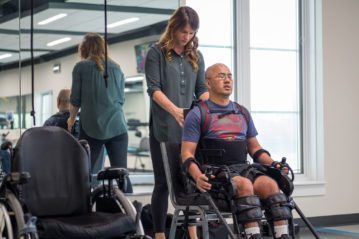 Flanked on all sides by his loving family, the support of his hometown community, and the undying brotherhood of his fellow officers, Tom began a process of recovery over an eight-month odyssey. He transferred first to Madonna Rehabilitation Hospital in Lincoln, Nebraska, and then to QLI in June.
Flanked on all sides by his loving family, the support of his hometown community, and the undying brotherhood of his fellow officers, Tom began a process of recovery over an eight-month odyssey. He transferred first to Madonna Rehabilitation Hospital in Lincoln, Nebraska, and then to QLI in June.
At the time of his transfer to QLI, Tom had reacquired specific skillsets, had begun to strengthen his body’s muscles and sharpen his mind’s tools. But those burgeoning strengths were isolated jigsaw pieces—pieces his injury had placed out of sight or flipped into obscurity.
With those pieces right-side up, QLI endeavored to complete the puzzle.
“Initially, my goal was to get back to work,” Tom said, “but as time progressed and I progressed through my rehabilitation process that became less and less important to me. More important was just getting back home and being a family man again. Being a father to my children and husband to my wife.”
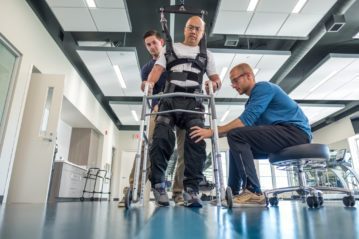 That focus became the lens, a singular perspective to color and hone every element of Tom’s recovery into a cohesive whole. Instead of providing rehabilitation in isolated, regimented sessions, QLI interwove every medical discipline into a comprehensive vision of Tom’s future. A combination of cutting-edge rehabilitation technology and physical therapy continued to maximize Tom’s strength and endurance. Cognitive therapy and speech therapy continued to optimize Tom’s ability to communicate and problem-solve in novel and dynamic situations. But all of it layered together to have specific relevance for the life Tom would lead after rehab.
That focus became the lens, a singular perspective to color and hone every element of Tom’s recovery into a cohesive whole. Instead of providing rehabilitation in isolated, regimented sessions, QLI interwove every medical discipline into a comprehensive vision of Tom’s future. A combination of cutting-edge rehabilitation technology and physical therapy continued to maximize Tom’s strength and endurance. Cognitive therapy and speech therapy continued to optimize Tom’s ability to communicate and problem-solve in novel and dynamic situations. But all of it layered together to have specific relevance for the life Tom would lead after rehab.
How would Tom cook independently, or do laundry, or function safely inside the home and the community? How would Tom manage appointments and his calendar? How would Tom spend time with his children, whether enjoying their favorite pastimes together or simply being a part of their lives? These were the questions his therapists asked, and these were the challenges that Tom himself rose to meet.
A traumatic brain injury had changed Tom’s life without regard for his control or his consent. Now, at QLI, Tom had the chance to change his life again. For the better.
—
On December 9th, 2017, Officer Tom Wagstaff donned his familiar police uniform and stood on his own two feet. He stood not in a hospital or in a rehabilitation center, but before an audience of hundreds from his home community.
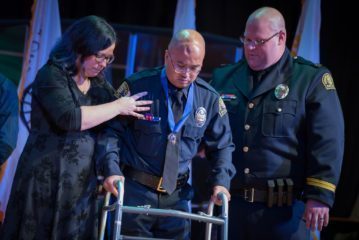 His wife beside him, Tom received a Distinguished Service Medal, and held his head high as a Purple Heart was pinned to his lapel. This was the capstone to an emotional ceremony that welcomed Tom back home, congratulated Tom on his recovery, and thanked Tom for all he had sacrificed to keep his city safe.
His wife beside him, Tom received a Distinguished Service Medal, and held his head high as a Purple Heart was pinned to his lapel. This was the capstone to an emotional ceremony that welcomed Tom back home, congratulated Tom on his recovery, and thanked Tom for all he had sacrificed to keep his city safe.
Indeed, he had sacrificed. Over the previous eight months his journey had been fraught with uncertainty and fear. But more powerful than his sacrifice was his willpower.
Despite a bullet in the head, he survived. Despite the gravest of prognoses, he endured. Despite the hardest of paths, he continued forward. And despite a perilous tightrope walk to recovery, he is still here.
Despite all that has changed, he is still Tom.
You can see Officer Wagstaff’s homecoming ceremony in this story from Kansas City’s Fox 4 News. And you can see Tom’s perspective of his recovery in this touching video:



